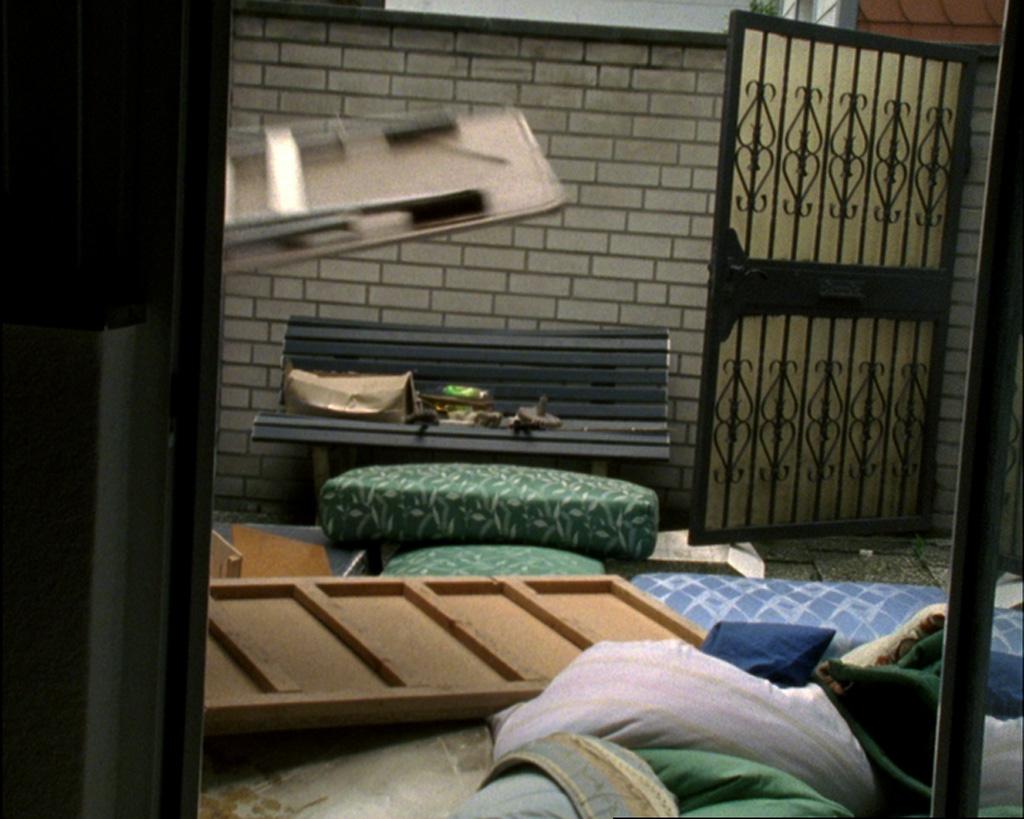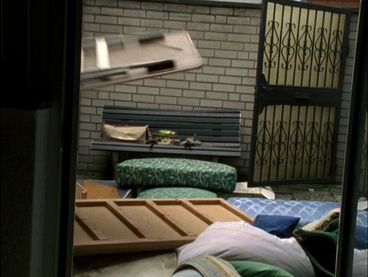MOOZ – audiovisual arts collection
Ankerstr. 62
2008, 8:10 min., color
Direction, screenplay, camera and editing: Matthias Stoll
Camera assistants: Elias Stabentheiner, Nina Poppe
Sound: Arne Münch
Production manager: Daniela Roos
Advisors: Prof. Werner Dütsch, Prof. Dietrich Leder
Production: Academy of Media Arts Cologne
This little house with a garden is the result of a lifetime of work. Recently inhabited, the objects that are still inside have lost significance with the sudden death of their owner. Within a single day all traces of the lonely life that has just come to an end are erased by a professional waste removal company. On November 5, 2012, at 11:20 p.m. the TV station Arte broadcast Matthias Stoll’s degree film Sterben nicht vorgesehen [Death unforeseen] as part of the program Kurz-Schluss.
Interview with Matthias Stoll
The short film Ankerstr. 62 was your first work at the KHM. In the documentary seminar, you had an assignment to document a process. How did you go about doing this project? How much time did you have to create this film?
My original idea was to document the cleaning of a jail cell, without really knowing what about this was interesting me. It was difficult for me as a young student to get permission to film in the jail, and after several failed attempts, I had to rethink. I had to consider what the core of my idea was and in the process I discovered that it was about the traces of human life. When this became clear to me, it was easy for me to write a clear and compelling plan for the project. Then I searched for professional waste removal services and got a positive answer with the first one I contacted.
In looking back on the project what was especially important to you as an experience in the process of filmmaking?
That an “idea” is not something that is fixed, it rather always represents a process that can and should change in the course of its development. The film was an important point of orientation for me as a filmmaker. I have discovered that human microcosms are what interest me, that I will never make political films or try to portray global contexts.
How did your view of the process shown in the film change during filming? Does film serve as material for a process or does it reproduce things and actions that are already resolved?
To be honest, I was searching for the positive aspects to the work of a removal company, for example, saving an especially personal object that still seems valuable even though or because the owner has died. I had a rather more warm-hearted film in mind. I was shocked by the coldness of the process, and I have highlighted this in the film using relevant scenes. There is nothing in the film that is already resolved. Because on a different day everything could have gone completely differently. Though, the film found its form through this day and this reality, through a process that was influenced by reality.
You do not just direct and write the screenplay in your films, you also operate the camera. Is the direct view through the camera paramount for you here? Why do you work in this way? Do you intend to continue like this?
Working with the camera is very important, and you have to have the right sensibility. I am not happy with the camera work in this film, however, I have learned a lot of important things in the process. I think that as a young filmmaker you should always be the one behind the camera. When you later work with others then you are already able to speak a common language. The outcome is even better the more people contribute their ideas and talents.
In Ankerstr. 62 a deceased person’s home is entirely cleared of belongings by a professional removal company; the traces of a life erased in a single day. In your degree film Sterben nicht vorgesehen [Death unforeseen] you tell of your father, his life, your time with him, and what remains after his death. Is this encounter with the themes of time, identity, and memory an important point of departure for you in your films?
In a word, yes. I am interested in the individual, in being human. Time, identity, and memory are important parts of this.
What themes are you currently dealing with?
I’m working on a feature-length documentary film, in which the older protagonists—all men—look back on their lives. They become authors of their own past, they engage with it in a creative way and flesh out short stories. I’m going to retell these short stories cinematically and weave them together. Of course this theme connects considerably with my work up until now.
Your films are strongly shaped by the editing process and by working with disparate material. You do not make classical documentary films. Do you tend more strongly toward an essayistic method?
I have distanced myself from any purist notions in documentary film. I have great admiration for filmmakers working in Direct Cinema, but I tend towards the opinion that all means can be used—provided that the feeling behind it is right. But here you have to also reassess with each new project, you can’t use one and the same scheme for every film. As a young filmmaker it is difficult to make essay films, because you are simply not yet credible enough to make various assertions. Someone like Herzog can manipulate and make claims as much as he likes, since one knows and respects the wealth of his experience. If a young filmmaker does this, then it’s embarrassing. In this respect I insert my own view only when I speak about myself and my own experiences. I follow the essayistic method but not with my own voice.
How do you cope as a filmmaker in a world transitioning towards the digital and at the same time with rigidly formatted media?
Those who can deal with the formats have always had greater chances that their films are produced and seen. That will also remain so in the future, but luckily it is not so important. What is more important, I think, is that filmmakers further develop themselves, seize this one opportunity. If you don’t run out of steam, the audience will appear naturally.
What forms of visibility or visual language do you think could evolve in interacting with Internet-specific or mobile platforms? Is that at all interesting to you?
Unfortunately Internet and mobile audiences are out for the quick fix—which seems to be quite the “inverse” of documentary film. Watching the most popular YouTube videos this becomes clear. It is natural of course, because on the computer (or worse: the smartphone) one does many things in parallel and attention span is miniscule. The popularity of documentary films will probably not be expanded through the Internet, but someone searching out a particular documentary film can certainly find it more easily.
More on Matthias Stoll and his essay film Sterben nicht vorgesehen here: http://sodakinda.com/sterben-nicht-vorgesehen-infos/
Matthias Stoll was born in 1983 in Singen. He lives and works in Cologne. Undergraduate studies at the Academy of Media Arts, Cologne, from 2005 to 2011. He earned his film degree with the essay film Sterben nicht vorgesehen.






